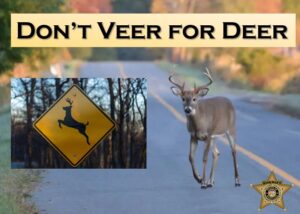 White-tailed deer activity is increasing because of the breeding season and drivers need to be especially vigilant during the fall months. White-tailed deer are more active from late October through December during the fall breeding season.
White-tailed deer activity is increasing because of the breeding season and drivers need to be especially vigilant during the fall months. White-tailed deer are more active from late October through December during the fall breeding season.
The breeding season, known as the rut, may cause deer to unexpectedly dart into roadways with little caution. Additionally, deer may move around more frequently, across wider areas, and at all hours of the day at this time of year. All these factors increase the risk of deer-vehicle collisions.
Deer Safety Driving Tips
- Be especially watchful at dawn and dusk when deer are more active. If you see one deer, expect others – deer seldom travel alone.
- Be alert and reduce speeds near wooded areas or green spaces and near water sources such as streams and ponds.
- Deer-crossing signs show areas where high numbers of vehicle-deer collisions have occurred in the past; but they can happen on any roadway, including city streets.
- Do not swerve to avoid hitting a deer. Motorists could then veer into oncoming traffic, run off the road, hit objects or overturn.
- Use bright headlights when there is no oncoming traffic to make spotting deer alongside the road easier and scan for the reflective eyes of deer.
- Always wear your seat belt, it’s the law, but if you hit a deer without a seatbelt on, you’re increasing your chance of serious injury.
- Stay the course. If a deer jumps out at you, calmly and firmly apply the brakes while staying in your lane. Swerving can put yourself and other drivers in danger.
If you do hit a deer, activate your vehicle’s hazard lights and move the vehicle out of the roadway, if possible. Report the collision to the police and wait for help to arrive. Contact your insurance agent or company as soon as possible to report vehicle damage. Stay safe out there!


